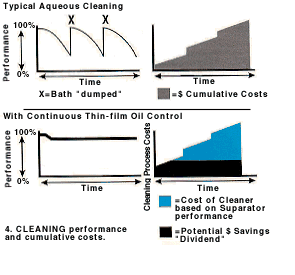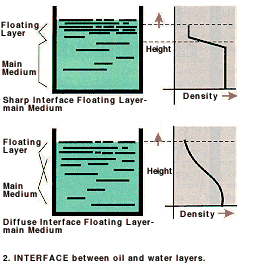Electroless Plating on Medical Catheters
Electroless plating project hopes to save lives...
There are more than 38 million patients hospitalized each year in the U.S. More than 50 pct of those receive some form of vascular infusion therapy where the skin is bridged by a catheter. Of the 20 million patients, it is estimated that more than a million recipients of catheters each year will develop an infection that could become life threatening.
When catheters were made of metal, infusion therapy problems were not as significant. Catheter-related infections and other unhealthy conditions have increased proportionately with the development of catheter designs made from plastics.
The problem is related to the catheter's surface material, which is not bio-compatible. Photomicrographs of the surface of the catheter show deep grooves that can harbor bacteria. (Fig. 1)
The purpose of the project was to design and develop an operating system to apply high-quality silver and platinum coatings on the inside and outside of the medical catheters. The emphasis was on quality pretreatment chemistry and improving the functionality of the metallic deposit.
The plating system was built and consisted of a series of 15- and 30-gal polypropylene dip tanks deep enough to plate standard-sized catheters up to 20 inches long. A fiberglass (FRP) structure was built to support the tanks and raise them to OSHA safety standards. An overhead shelf was built from fiberglass grating to accommodate pH meters, thermometers and glassware. The shelf supported a fluorescent light over the tanks. A 220- volt electrical line provided the power for the portable tank heaters.
Two special tanks with glass cylinders were built for the more costly precious metal solutions. Tank covers suppressed fumes and protected the chemistry from contaminants. Agitation was accomplished with work bar movement and pump recirculation. The silver tank was later redesigned to improve the plating quality and extend bath life.
Optimum production depended on precise parts racking. The production line and associated racking method could produce 120 standard-size urinary catheters an hour.
The plastic catheter surface is made from long-chain polymers, which are built with covalent and ionic bonds rather than metallic bonds. This simply means that the sea of free electrons does not exist, and the energy state of the polymer molecules is satisfied.
If you try to attach a metal ion to the atomic structure of a plastic, the initial layer of atoms will not adhere to the surface. Therefore, the surface chemistry must be altered to produce a surface that is chemically active and rough enough to produce an interlocking effect of the metal to the polymer.
To initiate deposition and insure adequate adhesion with bond strengths of 20,000 to 50,000 psi, special physical and mechanical processing means were used. The process required a roughening and undercutting of the surface so that the metallic atoms in the first few layers, and the ones that follow, stay in place mechanically. Thus adhesion results primarily from mechanical rather than the usual chemical means.
To produce the chemically active craggy surface, alkalines or solvent cleaner and acid or organic solvent and etchants attack the molecular chains of the polymer. These photomicrographs of the silver surface of the plated catheter compared to the surface of an unetched catheter, illustrate this feature. (Figs. 1, 2)
To initiate metallic deposition on plastics, the etched surface must be catalyzed. First the catheter is sensitized by dipping the plastic catheter into a solution of stannous chloride. The tin ions adsorb onto the surface. At this point, the surface film is changing from the smooth, low-energy, polymer-like surface to one of a higher energy state with tin ions attached to the surface. Immersion into an acid solution containing palladium chloride completes the catalyzation process. The palladium chloride dip catalyzes the surface, causes the palladium ions to be reduced to metallic palladium on the substrate while the Sn+2 is oxidized to Sn+4.
The non-conductive polymer is now conductive. It has nucleation sites of palladium metal and is ready for its functional electroless metallic finish.
Successful plating must be accomplished on a microscopic or molecular level. The plating process details are as follows:
1. Degreasing: Caustic cleaner or a cleaning process using isopropyl alcohol.
2. Rinse: Overflowing process water.
3a. Etch: Hot sulfuric-chromic acid etch at 65 to 70C. Process water rinse and demineralized water rinse. De-mineralized rinse exceeds 250,000 ohm-cm purity.
3b. Etch: Sodium naphthalene and diethylene glycol dimethyl ether at 50C for 30 to 60 seconds. Methyl or isopropyl alcohol rinse, acetic acid solution (pH 4-6), hot (70C) water rinse, demineralized ambient rinse. This process may require a second 60-second etch dip in the chromic-sulfuric tank after the hot water rinse.
4. Neutralization: Hydrochloric acid at 50 to 70C.
5. Sensitize: Acidified stannous chloride, ambient temperature.
6. Rinse: Demineralized water.
7. Catalyze: Acidified palladium chloride solution, ambient temperature.
8. Rinse: Spray.
9. Rinse: Demineralized water.
10. Electroless silver plate, ambient temperature to 30C.
11. Rinse: Demineralized water.
12. Electroless (or electrolytic) platinum or palladium plate.
13. Rinse: Demineralized water.
14. Dry.
The electroless process applies a thin coating of silver and platinum to both the outside and inside of the medical catheters. Medical catheters are thin-walled hollow tubes, primarily made from various forms of polymer compounds such as latex, polyamide, polyurethane and Teflon®. They vary in length from a few inches to 30 or more inches.
Depositing metals on a given substrate can be achieved using numerous methods. Electrodeposition is extensively used because it is convenient and relatively inexpensive. Although electroplating techniques may have a role in the development of a suitable anti-bacterial medical device, the most promising plating procedures are electroless.
Electroless plating is preferred because most medical catheters are electrically non-conducting and hollow. Electroplating can only produce deposits on the external areas of an electrically conductive part. Also, electroless plating will plate on any catalyzed surface on the inside and outside of the hollow device. Once the substrate or surface is catalyzed where metal nucleation sites exist, the chemical reaction will deposit metal. Electroless deposition is engineered to maintain bath stability (no reaction) until a suitable catalyst is present. The catalyzed surface produces sites that lower the activation energy of the chemical reaction, and the metal is reduced to the metallic state on the surface.
Advantages and Limitations. Electroless deposition is a special process with many advantages over electrolytic and other forms of metallizing.
- Electroless plating deposits metal on non-conducting materials such as plastics. Electroless is used exclusively to provide the initial metallic film needed for any subsequent electroplating or electroless topcoating.
- Electroless baths are simple to operate, performing over a range of temperatures and concentrations.
- Equipment is relatively simple. Chemical and physical vapor deposition processes require sophisticated vacuum reactors, induction coils and other equipment.
- Electroless does not depend on any laws of electrical current distribution. It will plate onto any shape, including the inside of hollow plastic tubes.
- Electroless plating deposits uniform, thin silver and platinum films from baths that are 99.9 pct pure.
- Electroless baths do not have surface area or spacing requirement limitations.
- True electroless processes have the ability to be autocatalytic, meaning that the deposit process is substrate catalyzed. The reaction does not stop once a layer of metal is plated; it will buildup.
There are some limitations to the electroless process:
- The rate of the process is a function of the concentration of the reducer at the interface of the substrate. Insufficient reducer slows deposition. Too much adversely affects bath stability.
- Solution makeup is complex. Tight control of chemistry is required.
- If the chemical stabilizers are inadequate, electroless baths can form free metal particles that coat the part and produce a rough surface finish. These free metal particles can also accumulate on the tank walls.
- Chemicals are more expensive than conventional electroplating chemicals, and the bath has a shorter life span. By-products accumulate and affect bath stability.
- Co-deposition of impurities is possible, especially toward the later stages of the bath's life.
It's a functional finish. Electroless chemistry is used to produce a functional coating. The purity of the coating is more important than the overall appearance. Electroless nickel coatings that have not been chemically altered to improve brightness, for example, do not resemble the brighter electrolytic platings that are more level and reflective.
Most plastics used for catheters have variations in their surface finish. Some are porous and rough, especially the latex variety. Some manufacturers of latex catheters coat them with Teflon or silicone to improve the texture. Because of this the resultant color of thin film coatings will vary with catheter types and variations in process chemistry.
The etch process can affect the color. Etching simply roughens the surface; however, this can alter the overall reflectivity. Rough surfaces are less reflective.
Thin electroless silver films are 99.9 pct pure or better. The coating is soft and porous like butter. The film can be scraped off with a sharp tool. However, it is not brittle or hard like electroless nickel and, therefore, does not produce any sharp edges or flake. It is compatible with the soft polymer substrate. The grain structure exhibits a relatively tight distribution of fine particles, similar to electroless gold.
Silver vs. Bacteria. The photomicrographs (Figs. 1, 2) show the surface of the catheter before and after electroless coating. The grooves in Figure 1 are areas that could entrap bacteria and make it difficult for cleaning. Silver is anti-bacterial and in small doses has no known toxic effect on the body. It is believed that the bacteria consume the silver ions, which are poison to the bacteria.
Although other metals, such as zinc, are bio-compatible, silver is chosen more often. Tests performed in Petri dishes with electroless and electroplated silver samples showed that silver provides protection from bacterial growth. (Fig. 3) When testing was performed within an organism, catheter-related infections were reduced significantly, and bacteria growth was controlled even when bacteria were introduced into the test specimens.
Work by Pourrezaei, Shvets, DeLaurentis and Beard at Drexel University showed a more detailed relationship between the silver metal coating on the catheter and the biological and chemical dynamics within the blood vessel. The testing showed that silver had a significant role in reducing bacterial growth in the ionic or dissolved chemical form rather than as a metallic surface film.
The key is not the presence of silver on the catheter, but the ability of the catheter to electrolytically dissociate silver ions. The initial chemical reaction is galvanic. For silver to dissociate to its ionic state, a thin layer of a more noble metal (such as platinum) was plated over the silver. The result was a more active silver surface and a significant decrease in bacterial growth around the silver and its interface.
The chemical reactions that help supply the silver ions are related to the good supply of chloride ions that already exists in the blood stream. When the silver metal undergoes oxidation and dissociates into the silver ion, it immediately reacts with the available chloride ions to form the compound silver chloride. It is thought the bacteria consume the silver ions. Once the silver ion becomes part of the chemistry of the bacteria, it dies.
The cost to plate a standard size catheter is about $4.00 each. Cost is determined by the thickness of the silver deposit, which is 1.3 to 2 micrometers. Platinum and palladium deposits are thinner at 0.1 to 0.2 micrometer.
Medical devices have been designed and engineered to improve the health of the patient. Those designed for infusion therapy are life-saving devices. However, current designs can hide risks to the patient, producing serious complications from infection or blood clotting.
Results indicate the electroless plating of medical devices will improve the surface engineering of catheters and stents. These improved devices will help reduce infections directly resulting from the medical devices designed to help the patient. Although production quantities of catheters are now possible, and more testing is on the horizon, there is much work ahead. It is hoped this project will became a precursor to more research and eventual widespread use of intravascular devices with improved surface engineering characteristics.
ACKNOWLEDGMENTS
The authors wish to express appreciation to Irina Shvets of P&D Medical Coatings, Dresher, Pennsylvania, for her assistance in preparing this manuscript. They also wish to acknowledge Caterpillar Inc., York, Pennsylvania, for donating chemicals used during the early phases of the project.
A special gratitude is given to James and Pattie Glatfelter of Anodizing of York, Dallastown, Pennsylvania. The company donated time, equipment and floor space for this project.
Related Content
Masking Solutions for Medical Applications
According to Custom Fabricating and Supplies, a cleanroom is ideal for converting, die cutting, laminating, slitting, packaging and assembly of medical-grade products.
Read MoreTop Shop Builds Original Systems for Coating Medical Devices
Engineers at Surgical Coatings in Colorado have been ingeniously developing their own equipment, automation, processes and software since this powder coater’s inception in 1995.
Read MoreFinishing High Reliability, Function Critical Parts
From safety critical automotive and aerospace components to lifesaving medical micro-components and implantable devices, Indiana-based Electro-Spec finishes applications that require zero failure rates.
Read MoreEngineered Coatings Offer Improvement for Medical Device Manufacturers
Diamond electroless nickel coating provides better lubricity and improved wear resistance for molds, resulting in better quality and productivity.
Read MoreRead Next
Delivering Increased Benefits to Greenhouse Films
Baystar's Borstar technology is helping customers deliver better, more reliable production methods to greenhouse agriculture.
Read MoreA ‘Clean’ Agenda Offers Unique Presentations in Chicago
The 2024 Parts Cleaning Conference, co-located with the International Manufacturing Technology Show, includes presentations by several speakers who are new to the conference and topics that have not been covered in past editions of this event.
Read MoreEducation Bringing Cleaning to Machining
Debuting new speakers and cleaning technology content during this half-day workshop co-located with IMTS 2024.
Read More

























